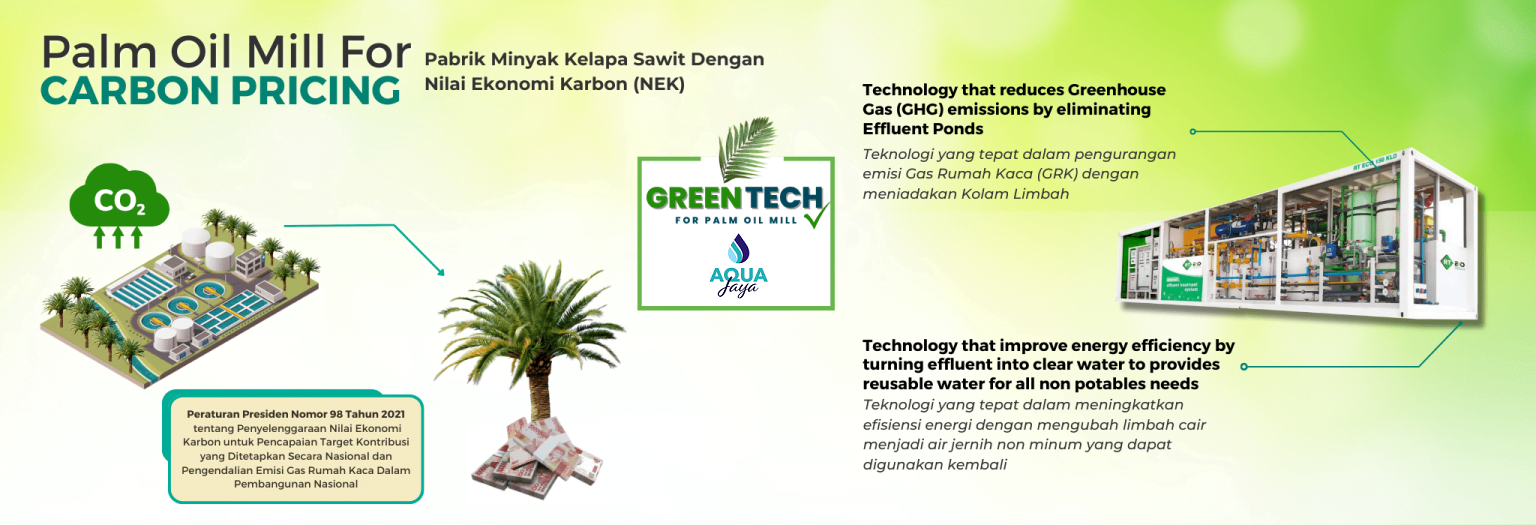Treatment
Palm Oil Mill Effluent Treatment Plant
Understanding the Term Carbon Credit
Quoting the IPCC report, Climate Change 2021, human influence causes significant global warming and this will greatly depend on greenhouse gas emissions or carbon emissions. Malaysia itself has committed to reducing its carbon emissions. The government has set an unconditional target of 29% and a conditional target of up to 41% compared to the Business as Usual (BaU) scenario in 2030.
As time goes on, so does the acceleration of global warming. The whole world must immediately make a significant contribution to reducing carbon emissions. This is where carbon credits act as an efficient mechanism.
Carbon credit concept
Carbon credits represent the right for a company to emit a certain amount of carbon emissions or other greenhouse gases in its industrial processes. One unit of carbon credit is equivalent to reducing emissions of 1 ton of carbon dioxide (CO2). Carbon credits become units traded in the carbon market for carbon offset activities.
Carbon offset is the activity of balancing a number of carbon emissions resulting from certain activities by purchasing carbon credits (in the voluntary market). Activities that produce carbon emissions include industrial activities and daily activities.
Where do carbon credits come from?
Carbon credits come from emissions reductions made by voluntary projects, where the project specifically aims to reduce emissions; such as turbine construction, methane reduction projects, or forest restoration.
Naturally, plants are able to absorb carbon dioxide and release oxygen back into the air through the process of photosynthesis. However, the rate of carbon dioxide production is much faster than its absorption capacity. With the growth of industry and population, the area of forest is increasingly limited to be converted into plantations, settlements, factories, and the like.
Simply put, green projects can submit their land absorption capacity calculations to an internationally recognized carbon credit verification agency. After obtaining certification for a number of carbon credits (each equivalent to 1 ton of CO2), the carbon credits are recorded in the depository (the institution responsible for storing the carbon credits). Only then can carbon credits be traded on the carbon market.
Carbon Credit Trading
Carbon unit trading or carbon credit trading is a mechanism that allows for market-based incentives for parties who succeed in making efforts to reduce carbon emissions. Countries that implement the cap and trade mechanism will determine a company’s carbon emission quota in a certain period based on predetermined criteria. Companies whose carbon emissions audit results are successful in achieving emission levels below the specified quota, can sell the remaining quota through the carbon market. Meanwhile, companies that exceed the quota must purchase the emission quota from other companies or face large fines.
Developed countries have long implemented this carbon trading mechanism. As a result, companies from various fields have taken concrete actions to reduce the carbon footprint produced by their business activities. Even regions such as the European Union have reached an understanding that net-carbon emission efforts cannot be achieved as long as imported products consumed by the European Union are still produced in regions that have not implemented emission reduction efforts. The result is the Cross Border Adjustment Mechanism (CBAM), which is an effort to ensure imported products meet the provisions relating to carbon emissions that apply in the European Union. If an imported product is deemed not to meet carbon emission requirements, European importers must purchase carbon credits to offset the carbon emissions produced in the manufacture of the product. This will of course make the price of the product more expensive and make it difficult to compete in the European Union region.
Even before Malaysia’s carbon emissions regulations were implemented, this policy in the European Union had an impact on Malaysian producers who exported to the European Union. If producers in Malaysia do not make efforts to mitigate carbon emissions, it will be difficult for their products to compete in the European Union.
Carbon Neutral Business Development
So what about local product producers who don’t export? What about business fields that only involve electricity, paper and fuel oil? Once again, carbon emissions trading will create incentives for those who can reduce emissions. Meanwhile, efforts to reduce emissions are not as easy as turning the palm of your hand. Preparations and processes are needed to achieve net-carbon emission business activities. By starting steps to achieve net-carbon emission business conditions from now on, it is an investment to anticipate the implementation of carbon emission regulations in Malaysia.
In addition, with increasing global awareness regarding net-carbon emissions, companies that can achieve net-carbon emissions will find it easier to become partners for companies that have awareness regarding carbon emissions. So that efforts to reduce emissions carried out now, apart from potential results from the carbon market, also have the potential for better business development in a carbon neutral business environment.
Maintaining the Number of Carbon Emissions Through Carbon Trading on the Exchange
The urgency of dealing with climate problems due to carbon emissions is increasingly urgent. Not only society, the government and private sector companies also need to make a global commitment to this problem.
Following this agreement, global carbon trading schemes were implemented to control the amount of carbon emissions released into the atmosphere. Regarding monitoring of carbon emissions, carbon trading is generally carried out through exchanges with certain unit standards.
The carbon referred to in carbon trading on the exchange is carbon credits. Carbon credits themselves have been recognized internationally as a commodity. Therefore, the exchange ecosystem will facilitate organized and efficient carbon trading.
